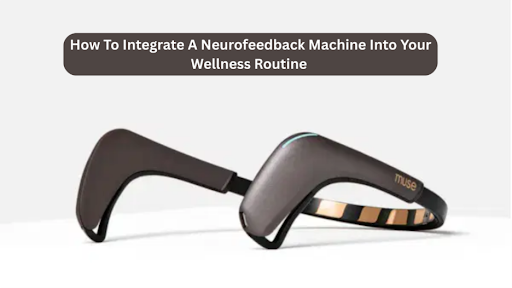Wellness has evolved beyond the realm of green smoothies, yoga classes, or meditation playlists. Today, technology is transforming how we think about mental and emotional wellness, and one of the most fascinating breakthroughs is neurofeedback.
Speaking of which, consider the possibility of being able to view in real time how your brain operates and then conditioning it to improve. Neurofeedback machines give you the chance to do that.
These gadgets help you become more focused, less stressed, sleep better, and perform more advanced cognitive tasks by tracking brainwave activity.
Yet here is the big question: how are you going to turn the mere possession of a neurofeedback gadget into something that makes a positive, healthy difference to your everyday wellness routine?
Throughout this guide, we will look at the science of neurofeedback, why it is important, and above all, how you can practically incorporate it into your life to achieve long-term results.
What is Neurofeedback?

Neurofeedback is a type of biofeedback that specifically targets the brain. It uses special software and sensors to monitor the brainwave patterns and delivers real-time feedback, usually via visual or audio.
In the long run, this feedback will allow your brain to self-regulate, shifting the activity patterns towards a more balanced and efficient movement. Moreover, individuals use neurofeedback for a broad spectrum of advantages, including:
- Increased attention and efficiency
- Dealing with stress and anxiety
- Better sleep quality
- Enhancing meditation and mindfulness activities
- Helping with ADHD or cognitive function
Therefore, with the development of technologies, clinical-level brain training is no longer limited to clinics.
Moreover, as highlighted by a popular wellness resource called Outliyr, a modern neurofeedback machine is designed for everyday use—allowing individuals to seamlessly integrate brain training into their routines from the comfort of home.
Step-by-Step Guide: Incorporating a Neurofeedback Device Into Your Life
These easy steps will allow you to naturally integrate neurofeedback into your daily routine and turn brain training into a practice that benefits concentration, relaxation, and overall psychological health.
1. Select the Proper Device

Picking a good neurofeedback machine will guarantee long-term success. When choosing equipment, you need to think about the convenience of installation, mobility, sensor type, and the number of training protocols it can provide.
For example, inexperienced users are likely to find headband-type devices simple to use and requiring little setup. Contrarily, more advanced users can benefit from multiple sensors and customizable software systems.
In short, think about your goals, budget, and lifestyle. That is crucial because by selecting a device that aligns with your everyday activities, you are more likely to use it regularly and effectively.
2. Establish Specific Goals
It is good to define the purpose of using the neurofeedback machine so that it will guide all your training and keep you motivated as well. For instance, do you want to lower stress levels, focus better at work, sleep better, or have it support your meditative practices?
By identifying such goals clearly, you can objectively measure progress and customize your sessions to make them as beneficial as possible. Without proper targets, you can easily lose track of your progress.
You can also keep a journal or digital recording of your sessions, which helps strengthen your commitment and accountability.
3. Set a Regular Schedule of Sessions
Neurofeedback requires consistency to achieve long-term results. On that note, experts suggest 20-40-minute sessions 2-4 times a week, preferably at about the same time every day.
You can also plan sessions around your life. For instance, in the morning to improve focus and energy, during the day to reduce stress and improve mental clarity, or in the evening to relax and prepare for a good night’s sleep.
Overall, creating a routine for your sessions will turn neurofeedback into a healthy exercise and not a temporary experiment.
4. Provide a Non-Distractive Environment
The setting in which you undergo training is a key factor in the effectiveness of neurofeedback. An environment that is quiet, comfortable, and interruption-free allows your brain to respond best based on real-time feedback.
For this reason, take into account dim light, ergonomic chairs, and a stable internet in case your device requires connectivity. Reducing cellphone alerts or other outside sounds will help avoid disturbances that can undermine your session results.
All in all, creating a separate place to do neurofeedback will help you and your brain know it is time to focus. It will cause every session to be more effective and purposeful.
5. Combine Neurofeedback with Other Practices

Enhance neurofeedback effects with complementary wellness activities. Mindfulness meditation strengthens relaxation and awareness, enabling the brain to respond better to training.
Before or after a session, some light exercise or yoga can also improve circulation and cognitive receptivity. You can even monitor progress by writing about your mood, sleep, and concentration levels.
These practices can be complemented to form a complete daily pattern that promotes mental clarity, emotional resilience, and general cognitive health. Eventually, it will help to achieve the long-term effects of neurofeedback.
Training Your Brain, Transforming Your Life
Integrating a neurofeedback machine into your wellness routine isn’t just about adding another gadget—it’s about reshaping how you connect with your own mind.
From sharper focus to deeper relaxation, each session is an opportunity to fine-tune your brain’s rhythms and unlock new levels of clarity. The key lies in consistency, patience, and pairing the practice with your existing wellness habits.
As a consequence, with the right approach, neurofeedback can become more than a tool—it can be a trusted ally in your journey toward balance, resilience, and long-term mental performance.



